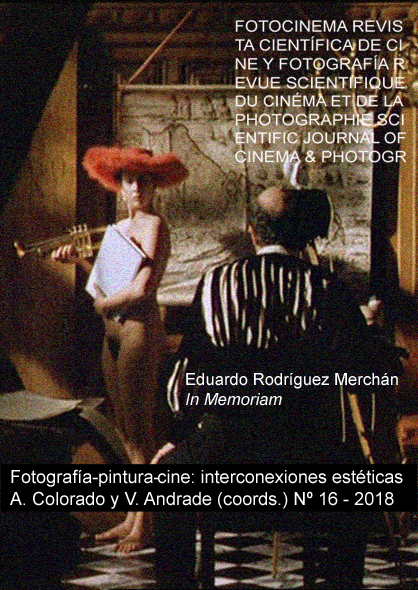Keys of Baroque painting in Akira Kurosawa’s black and white cinema
DOI:
https://doi.org/10.24310/Fotocinema.2018.v0i16.4093Keywords:
Akira Kurosawa, Intertextuality, Narrative, Visual Key, Baroque Painting, ChiaroscuroAbstract
In the academic studies that approach the films of Akira Kurosawa (1910-1998) prevail the literary and sociological perspectives. Two fundamental reasons explain such proposals, such as the admiration of the filmmaker for the English playwright, and his eagerness to investigate the light and shadow of the Japanese society in which he lived. This article detaches itself from those perspectives to approach Kurosawa's work from a pictorial point of view, in an attempt to identify and explain some of the visual cues that from this discipline are incorporated into his images. In particular, attention is paid to the influence of baroque painting in its black and white production, which adds up to 24 films made between 1943 and 1970. Five defining keys of Kurosawa's narrative style have been identified in these years: chiaroscuro, triangular composition, the intensification of narrative time, the use of nature as an emotional metaphor, and the tension of forms.
Downloads
Metrics
Publication Facts
Reviewer profiles N/A
Author statements
Indexed in
-
—
- Academic society
- N/A
- Publisher
- Universidad de Málaga
References
Barthes, R. (1991). El imperio de los signos. Madrid: Mondadori.
Berger, J. (2000). Modos de ver. Barcelona: Gustavo Gili.
Cardullo, B. (1985). The Circumstance of the East, the Fate of the West: Notes, Mostly on “The Seven Samurai”. Literature/Film Quarterly, vol 13, nº2, pp. 112-117.
Cardullo, B. (2008). Akira Kurosawa: Interviews (Conversations with Filmmakers). Jackson, Mississippi: University Press of Mississippi.
Cho, F. (2015). The Play of Shadows in Japanese Cinema. Material Religion, vol. 11, nº4.
Einstein, C. (2008). El arte como revuelta. Escritos sobre las vanguardias (1912-1933). Madrid: Lampreave & Millán.
Etxebeste, Z. (2003). Un pintor de celuloide. Nosferaru, nº43-44.
Galbraith IV, S. (2005). El Emperador y el Lobo. La vida y películas de Kurosawa y Mifune. Madrid: T&B.
García Landa, J.A. (1998). Acción, relato, discurso. Estructura de la ficción narrativa. Salamanca: Universidad de Salamanca.
Gombrich, E. H. (2008). La historia del arte. Nueva York: Phaidon.
Goodwin, J. (1993). Akira Kurosawa and Intertextual Cinema. Baltimore. Hopkins University Press.
Goodwin, James (2011). El arte de Akira Kurosawa: un comentario. En Fundación Colección ABC y TF Editores (ed.), Los dibujos de Akira Kurosawa. La mirada del samurái (pp. 21-29). Madrid: Fundación Colección ABC y TF Editores.
Grandío, M. (2010). Tiempo y perspectiva en la película Rashomon de Akira Kurosawa. Vivat Academia, nº111, pp. 88-106.
Harris, M.W. (2013). Jazzing in the Tokyo slum: music, influence, and censorship in Akira Kurosawa's Drunken Angel. Cinema Journal, vol. LIII, nº1.
Kane, J. (1997). From the Baroque to Wabi: Translating Animal Imagery from Shakespeare’s King Lear to Kurosawa’s Ran. Literature/Film Quarterly, vol. 25, nº2, pp. 146-51.
Kurosawa, A. (2000). Autobiografía (o algo parecido). Madrid: Fundamentos.
Leborg, C. (2016). Gramática visual. Barcelona: Gustavo Gili.
McDonald, K.I. (1982). Light and Darkness in Rashomon. Literature/Film Quarterly, vol. 10, nº2, pp. 120-29.
Parker, B. (1997). Nature and Society in Akira Kurosawa's Throne of Blood. University of Toronto Quarterly, vol. 66, nº3. pp. 508-25.
Prince, S. (1999). The Warrior's Camera: The Cinema of Akira Kurosawa. Princeton, Nueva Jersey: Princeton University Press.
Prince, S. (2008). Mecha Samurai: Kurosawa in the World of Anime. Film and the Humanities, vol. 28, nº2.
Ramos Arteaga, J.A. (2010). De providentia et chaos: Trono de sangre de Akira Kurosawa. Revista Latente: revista de historia y estética del audiovisual. nº8, pp. 206-210.
Richie, D. (1986). The Films of Akira Kurosawa. Berkeley, Los Ángeles: University of California Press.
Roe, S. (2008). Vida privada de los impresionistas. Madrid: Turner.
Tassone, A. (2011). Akira Kurosawa: el emperador humanista. En Fundación Colección ABC y TF Editores (ed.), Los dibujos de Akira Kurosawa. La mirada del samurái (pp. 31-45). Madrid: Fundación Colección ABC y TF Editores.
Tassone, A. (2008). Akira Kurosawa. Milán: Il Castoro.
Van de Wetering, E. (1997). Rembrandt: The Painter at Work. Ámsterdam: Amsterdam University Press.
Wild, P. (2015). Akira Kurosawa. Londres: Reaktion Books.
Yoshimoto, M. (2010). Kurosawa: Film Studies and Japanese Cinema. Durham (Carolina del Norte): Duke University Press.
Zuffi, S. (1999). Baroque Painting. Hauppauge, Nueva York: Barron's.
Downloads
Published
How to Cite
Issue
Section
License
All contents published in Fotocinema Revista científica de cine y fotografía are protected under the Creative Commons Attribution-NonCommercial-ShareAlike 4.0 International (CC BY-NC-SA 4.0) license. All about this license is available in the following link: <http://creativecommons.org/licenses/by-nc-sa/4.0>
Users can copy, use, redistribute, share and exhibit publicly as long as:
- The original source and authorship of the material are cited (Journal, Publisher and URL of the work).
- It is not used for comercial purposes.
- The existence of the license and its especifications are mentioned.
There are two sets of authors’ rights: moral and property rights. Moral rights are perpetual prerogatives, unrenounceable, not-transferable, unalienable, imprescriptible and inembargable. According to authors’ rights legislation, Fotocinema. Revista científica de cine y fotografía recognizes and respects authors moral rights, as well as the ownership of property rights, which will be transferred to University of Malaga in open access. The property rights are referred to the benefits that are gained by the use or the dissemination of works. Fotocinema. Revista científica de cine y fotografía is published in an open access form and it is exclusively licenced by any means for doing or authorising distribution, dissemination, reproduction, , adaptation, translation or arrangement of works.
Authors are responsable for obtaining the necessary permission to use copyrighted images.














13.png)



